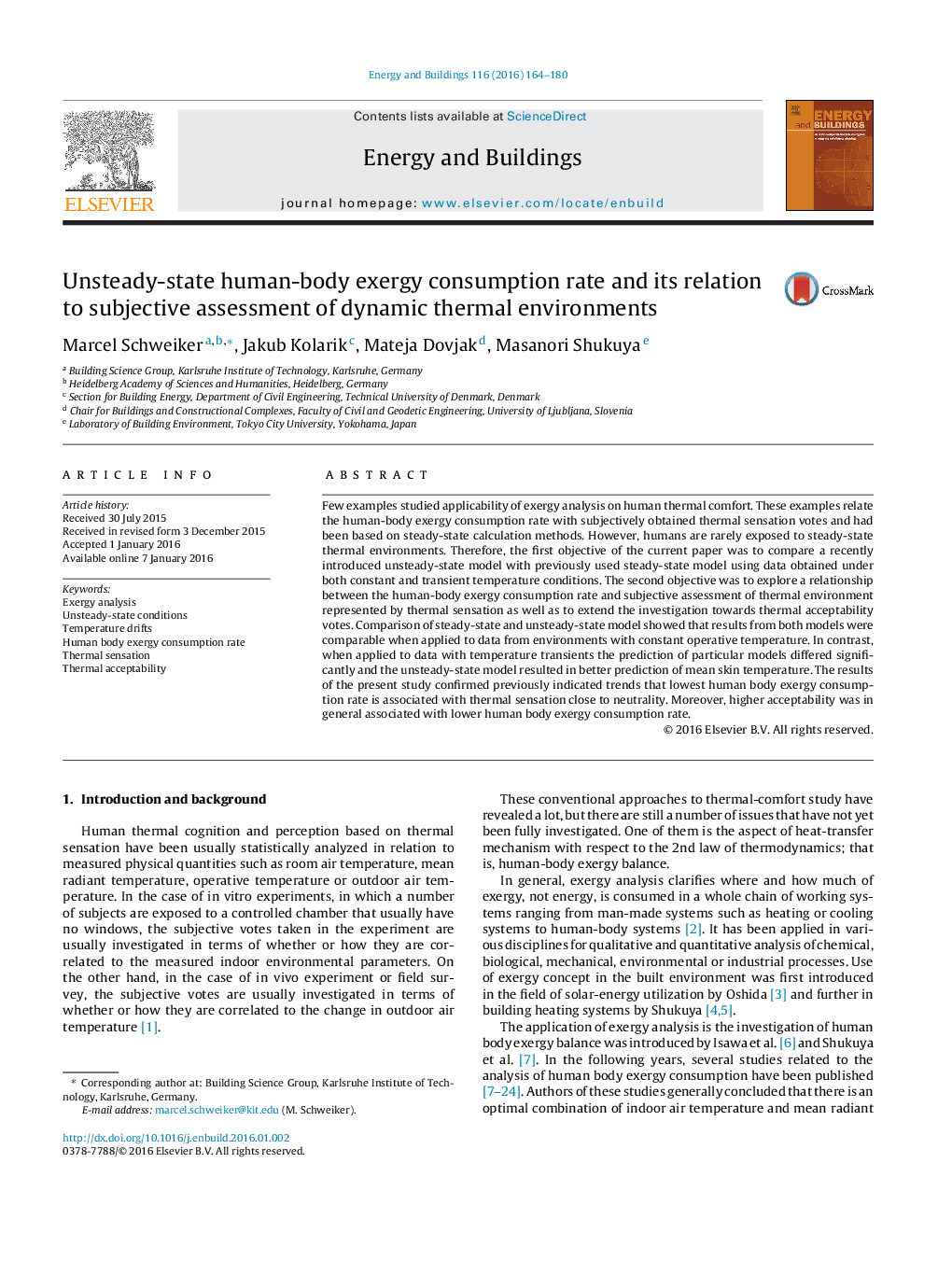| کد مقاله | کد نشریه | سال انتشار | مقاله انگلیسی | نسخه تمام متن |
|---|---|---|---|---|
| 6730463 | 504021 | 2016 | 17 صفحه PDF | دانلود رایگان |
عنوان انگلیسی مقاله ISI
Unsteady-state human-body exergy consumption rate and its relation to subjective assessment of dynamic thermal environments
ترجمه فارسی عنوان
میزان مصرف بیرویه اگزرژی بدن انسان و عدم ارتباط آن با ارزیابی ذهنی محیط های حرارتی پویا
دانلود مقاله + سفارش ترجمه
دانلود مقاله ISI انگلیسی
رایگان برای ایرانیان
کلمات کلیدی
تجزیه و تحلیل اگزرژی، شرایط نامساعد وضعیت رطوبت دما، میزان مصرف اگزرژی بدن انسان، احساس گرمایی پذیرش حرارتی،
ترجمه چکیده
نمونه های کمی مورد استفاده قرار گرفت از کاربرد اکسرژی در آرامش حرارت بدن انسان. این مثال ها میزان مصرف اضافی انرژی بدن انسان را با ارجاع حس گرای حرارتی ذاتی به دست می آورد و براساس روش های محاسبه حالت پایدار است. با این حال، انسان به ندرت به محیط حرارتی حالت پایدار در معرض قرار می گیرد. بنابراین هدف اول مقاله حاضر، مقایسه یک مدل جدید ناپایدار دولت با مدل پیشین دولت ثابت با استفاده از داده های به دست آمده در هر دو شرایط ثابت و گذرا بود. هدف دوم این بود که کشف رابطه بین میزان مصرف انرژی اضافی انسان و بدن و ارزیابی ذهنی محیط حرارتی به وسیله حس گرما و نیز گسترش تحقیقات در مورد رأی های پذیرش حرارتی انجام شود. مقایسه مدل حالت ثابت و ناپایدار نشان داد که نتایج هر دو مدل هنگامیکه داده ها از محیط های با دمای ثابت عمل می کنند قابل مقایسه باشند. در مقابل، هنگامی که به داده ها با تغییرات دما اعمال شد، پیش بینی مدل های خاصی به طور قابل توجهی متفاوت بود و مدل ناپایدار حالت نتایج پیش بینی بهتر دمای متوسط پوست را به دنبال داشت. نتایج مطالعات حاضر نشان داد که ریزترین میزان مصرف مواد اضافی بدن انسان با حساسیت حرارتی نزدیک به بی طرفی همراه است. علاوه بر این، پذیرش بالاتری به طور کلی با میزان مصرف اضافی انرژی بدن انسان ارتباط داشت.
موضوعات مرتبط
مهندسی و علوم پایه
مهندسی انرژی
انرژی های تجدید پذیر، توسعه پایدار و محیط زیست
چکیده انگلیسی
Few examples studied applicability of exergy analysis on human thermal comfort. These examples relate the human-body exergy consumption rate with subjectively obtained thermal sensation votes and had been based on steady-state calculation methods. However, humans are rarely exposed to steady-state thermal environments. Therefore, the first objective of the current paper was to compare a recently introduced unsteady-state model with previously used steady-state model using data obtained under both constant and transient temperature conditions. The second objective was to explore a relationship between the human-body exergy consumption rate and subjective assessment of thermal environment represented by thermal sensation as well as to extend the investigation towards thermal acceptability votes. Comparison of steady-state and unsteady-state model showed that results from both models were comparable when applied to data from environments with constant operative temperature. In contrast, when applied to data with temperature transients the prediction of particular models differed significantly and the unsteady-state model resulted in better prediction of mean skin temperature. The results of the present study confirmed previously indicated trends that lowest human body exergy consumption rate is associated with thermal sensation close to neutrality. Moreover, higher acceptability was in general associated with lower human body exergy consumption rate.
ناشر
Database: Elsevier - ScienceDirect (ساینس دایرکت)
Journal: Energy and Buildings - Volume 116, 15 March 2016, Pages 164-180
Journal: Energy and Buildings - Volume 116, 15 March 2016, Pages 164-180
نویسندگان
Marcel Schweiker, Jakub Kolarik, Mateja Dovjak, Masanori Shukuya,
